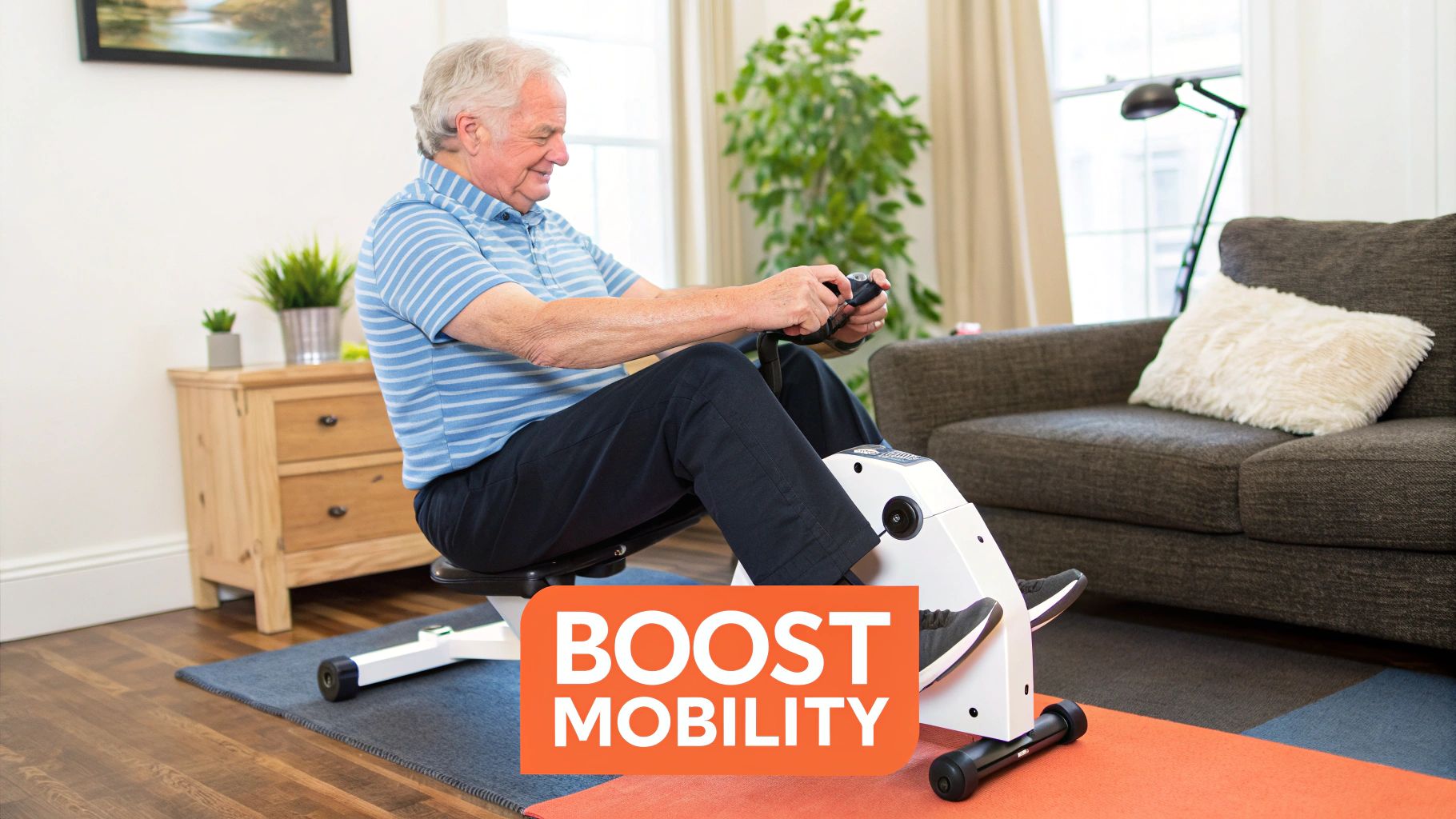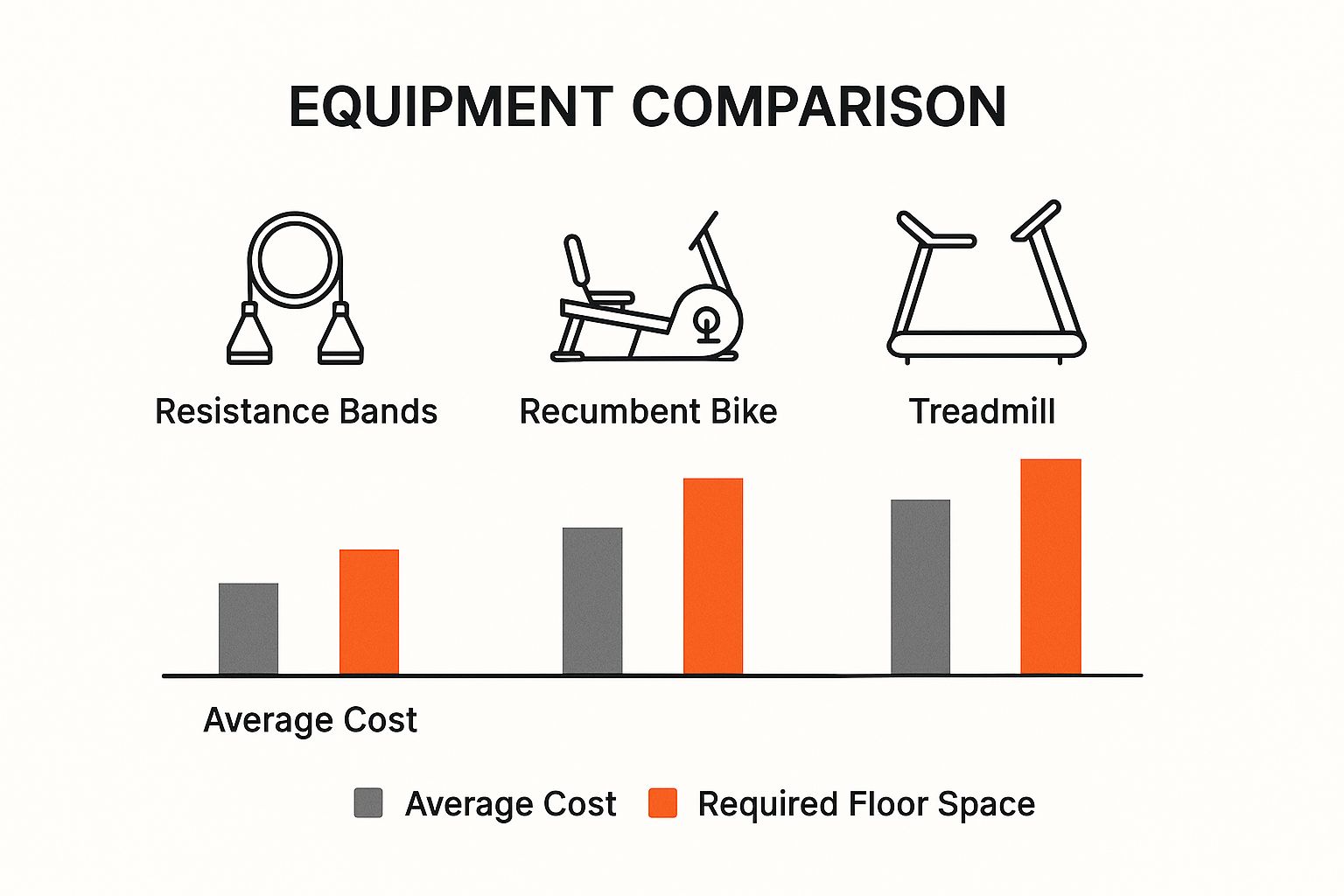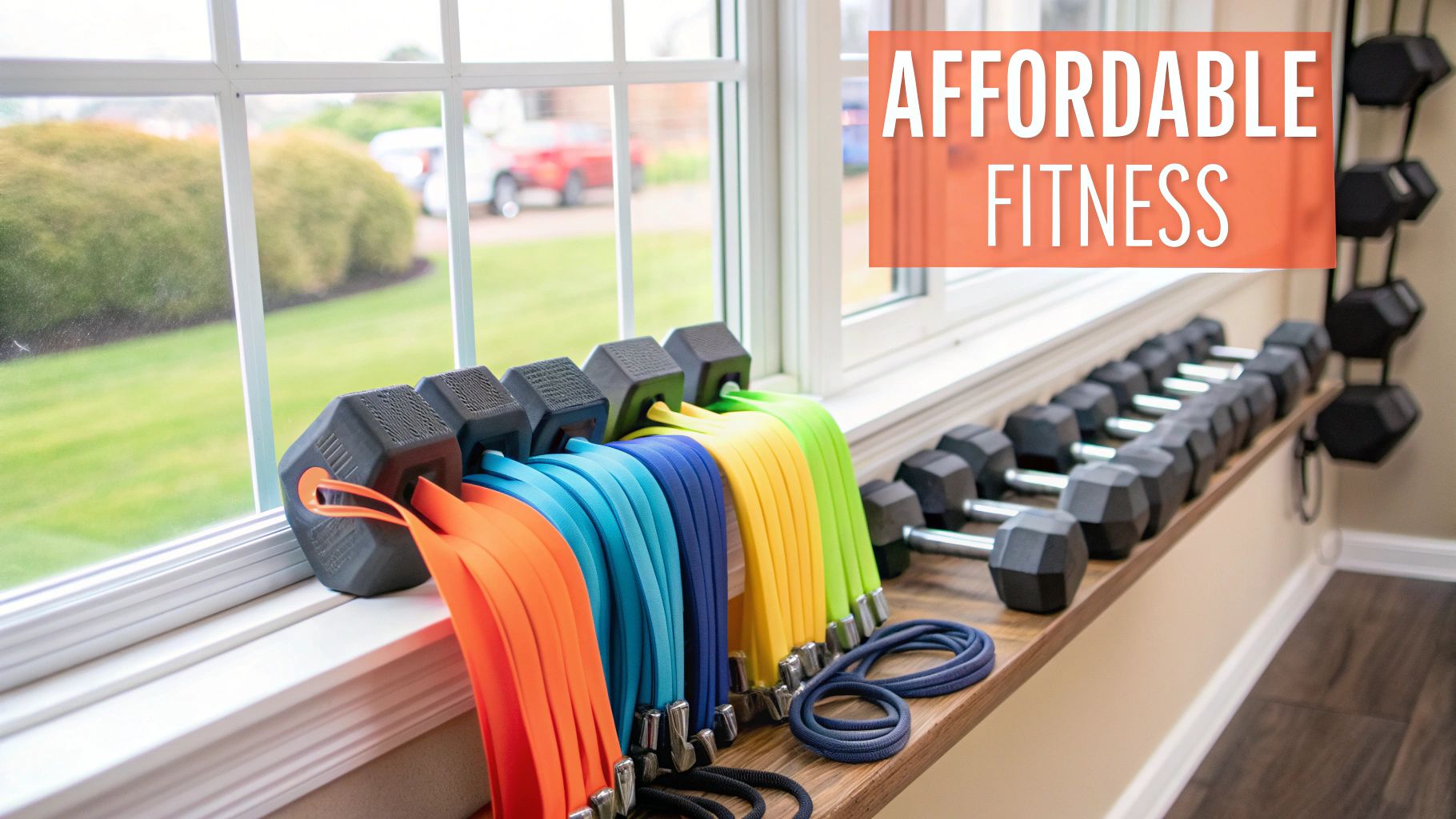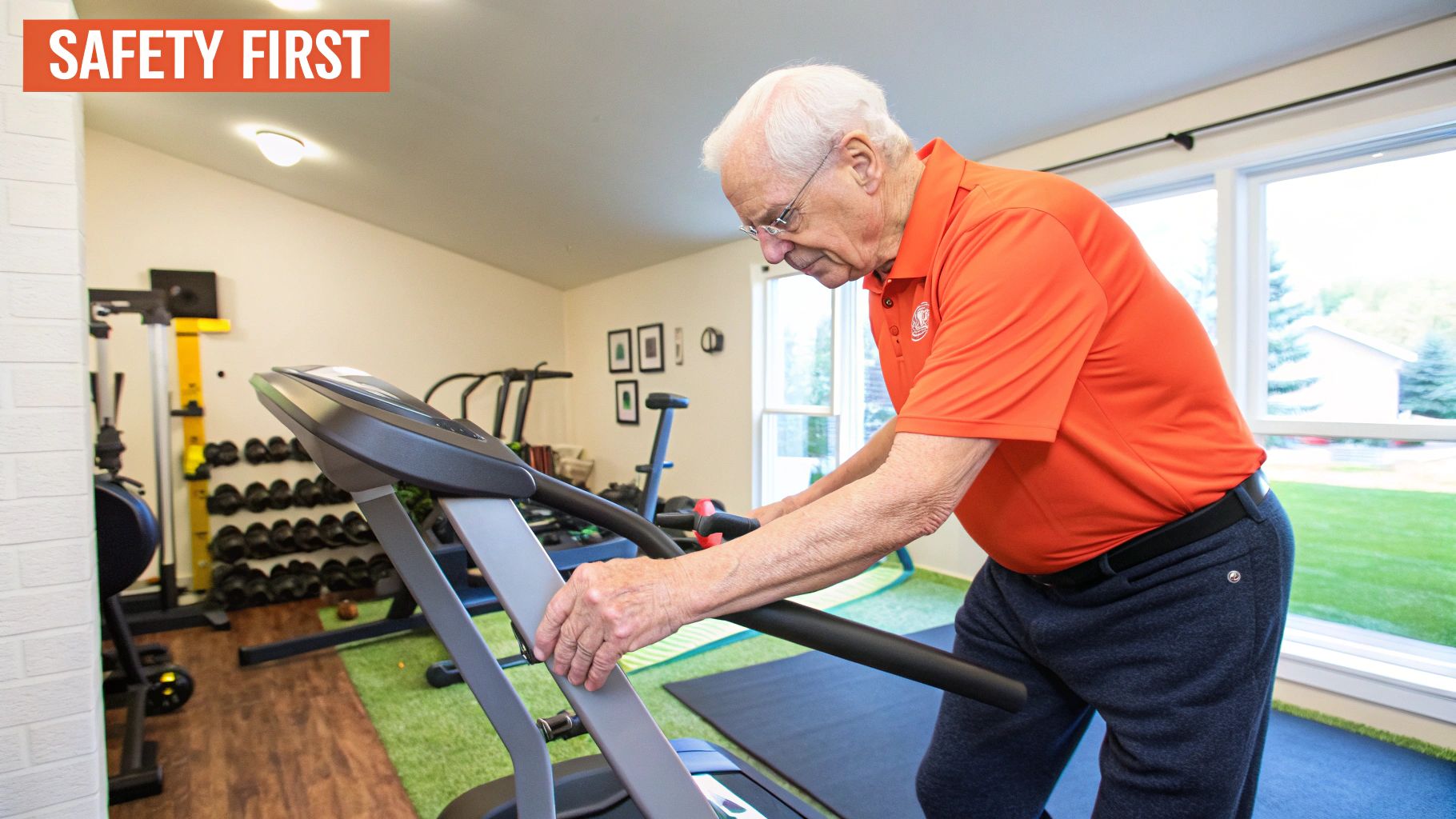-
CALL US:
- (866) 952-3456
When you think about the best home exercise equipment for seniors, you're really looking for tools that are gentle on the body. Things like recumbent bikes, simple resistance bands, and treadmills with sturdy safety handrails are fantastic options. They help you build up your heart health, strength, and balance without putting a ton of stress on your joints, which makes getting fit feel both safe and achievable.
Having your own little fitness corner at home is so much more than just a matter of convenience. For a lot of seniors, it’s a huge step toward staying independent, feeling vibrant, and taking charge of their own health. When you can exercise in a place you know and feel comfortable in, it knocks down some big hurdles—like dealing with transportation, paying for gym memberships, or feeling a bit out of place. It just makes sticking to a routine that much easier.
This move toward working out at home isn't just a passing phase, either. The global market for home fitness gear was valued at around USD 18.18 billion and is expected to push past USD 20 billion soon. That growth is all about people becoming more health-conscious and wanting to take care of themselves, especially older adults who might be managing things like arthritis or diabetes.
Staying active right where you live can make a world of difference for your mobility, your confidence, and how you feel day-to-day. With the right equipment, it's completely within reach.
The real magic of having home exercise equipment for seniors is the sense of empowerment it gives you. It changes wellness from something you have to go out and get into something you can build right in your own living room, on your own schedule.
If you're looking for gentle workouts to do at home, you might find that activities like Qi Gong classes are a wonderful way to boost both your balance and mental calm. As you start thinking about what equipment you might need, it helps to start with the basics. For anyone just beginning to set up a space, our guide on home gym equipment essentials is a great resource that covers the foundational pieces for any home gym.

Before you bring any new exercise equipment into your home, it’s best to think like a safety inspector. Choosing the right home exercise equipment for seniors isn't so different from picking out a new car. You wouldn't just look at the paint color, would you? Of course not. You’d check the safety ratings, how comfortable the seats are, and how easy it is to drive.
The same exact logic applies right here. Safety and usability aren't just nice-to-have features; they're the foundation for a workout routine you can feel confident and good about.
Think about it like this: low-impact designs are like a great suspension system in a car. They absorb all the bumps and jolts so your body doesn't have to. Equipment that’s gentle on your joints—like recumbent bikes or ellipticals—is a lifesaver for your knees and hips, which is absolutely crucial for staying active without aches and pains.
This mindset helps you build yourself up, without the risk of those nagging wear-and-tear injuries. It’s the key to making consistent, long-term progress.
One of the first things you should check is stability. Any machine you get on should feel as solid as a rock underneath you. A wobbly piece of equipment is just an accident waiting to happen.
Here’s a quick checklist to make sure your workout is secure:
These features give you a stable foundation. That way, you can focus on your exercise instead of worrying about keeping your balance.
Let's be honest. If a machine is a pain to use or just plain uncomfortable, you're not going to use it. User-friendly design is what turns exercise from a chore into a lasting habit.
An accessible machine invites you to exercise. Look for clear, large-print digital displays that are easy to read without squinting, and controls that are intuitive to adjust. Ergonomic seats and cushioned grips make your workout more pleasant from start to finish.
Plus, a lot of modern equipment has features that can really help your journey. Some machines now offer AI-driven guidance, giving you personalized exercise plans and even real-time feedback on your form. It makes exercising feel less intimidating and more like a welcome part of your day.
Don't forget to think about assembly, either. Some of this equipment can be surprisingly complex to put together, and if it's not set up correctly, it can be a serious safety hazard. You might want to check out some pointers on how to properly assemble fitness equipment to make sure everything is sturdy and secure before that first workout.
Choosing the right home exercise equipment for seniors isn't about finding the "best" machine out there. It’s about finding the right machine for you. Think of it like hiring a personal trainer. You wouldn't bring in a powerlifting coach if your real goal was to improve your balance and run your first 5K.
The same idea applies here. The equipment you pick should be a direct match for what you want to achieve, whether that’s a stronger heart, better functional strength for daily life, or just moving with less pain and stiffness. When your tools align with your goals, you're setting yourself up for success from day one.
If your doctor has mentioned getting your cardiovascular health in better shape, you'll want to look at low-impact aerobic machines. These are brilliant because they get your heart rate up and build stamina without hammering your joints.
Let's be clear: building strength isn't about lifting massive weights. It's about maintaining the muscle you need for everyday activities—things like carrying groceries, playing with grandkids, or getting up from a chair with ease. For that, gentle resistance is your best friend.
The image below gives you a quick snapshot of how a few popular types of equipment compare in terms of cost and the space they'll take up in your home.

As you can see, something like resistance bands requires almost no space and is very friendly on the wallet. On the other hand, a quality treadmill is a bigger investment in both money and floor space.
Having good balance is one of the most important factors in preventing falls, and staying flexible helps you move more freely with less pain. Working on these areas consistently with the right tools can make a world of difference.
Did you know that consistent exercise can reduce the risk of falls in seniors by up to 42%? That finding from the World Health Organization really shows how vital this kind of training is for staying independent.
You don't need anything complicated. Simple tools can be incredibly effective here:
Once you’ve picked out the equipment that feels right for your goals, the next step is getting it put together correctly. This is especially true if you've invested in a larger machine. Your safety depends on it being built properly. For expert help, you can find more information about professional assembly of your fitness equipment to make sure your workout station is secure and ready to go.

You absolutely do not need a dedicated home gym or a huge budget to build a fantastic fitness routine. A lot of folks think getting started means buying bulky, expensive machines, but that’s just not true. Some of the most helpful home exercise equipment for seniors is surprisingly small and affordable.
The trick is to find versatile tools that give you big results without taking over your living room. It's an approach that makes great fitness possible for just about anyone. In fact, more and more seniors are turning corners of their homes into personal fitness nooks with things like resistance bands and balance trainers, which are much kinder to sensitive joints. You can even learn more about this trend and government support for active aging.
These budget-friendly items are your secret weapons for a well-rounded fitness plan, right in the comfort of your home.
Think of this compact gear as a Swiss Army knife for your health. They might not look like much, but they are incredibly effective for boosting your strength, mobility, and balance.
Let's look at a few excellent options that really pack a punch.
Getting into a routine is much simpler than you might think. You can easily put together a full-body workout with just these few items.
The goal isn't to become a bodybuilder. It's about building functional strength that improves your quality of life. Consistent, gentle exercise with the right tools is what makes daily activities—like carrying groceries or climbing stairs—feel easier and safer.
Here’s a simple routine you can try:
The absolute best piece of home exercise equipment for seniors is only as helpful as the space you put it in. Setting up a dedicated workout area isn't just about getting organized; it's about creating a safe, welcoming environment that gets rid of excuses and makes you want to show up every day.
Think about it like setting up a great kitchen—if all your ingredients and tools are easy to find and the lighting is good, you're much more likely to actually cook a healthy meal instead of ordering takeout. The same logic applies here.
Your workout spot should be your personal fitness sanctuary. The first thing to figure out is location. Try to pick a spot with plenty of natural light and good airflow. A bright, airy space can lift your mood before you even do a single stretch, while a dark, stuffy corner will just feel draining.
Next, think about the floor. You need a stable, non-slip surface, period. A low-pile carpet or hardwood floor is usually perfect. Stay away from thick, plush rugs that can bunch up or slide around—they’re a major tripping hazard just waiting to happen.
Once you’ve found your spot, it’s time to think about the layout. Giving yourself enough clearance isn’t just a nice-to-have; it's a non-negotiable safety rule. You need enough room to move around your equipment without banging into furniture or walls.
A good rule of thumb is to have at least 2-3 feet of clear space on all sides of any machine. This buffer zone is what allows you to get on and off safely and move through your exercises without feeling boxed in.
A safe workout area is one where everything you need is within arm's reach. You should never have to stop mid-workout and walk across the room for a sip of water or to grab your phone.
Before you even think about starting your routine, make sure these items are right beside you:
Finally, let’s have a frank talk about assembly. Most exercise equipment shows up in a big box with a set of instructions that can look pretty intimidating. If you feel even a little bit unsure about putting it all together, the smartest and safest thing you can do is ask for help. A machine that's not assembled correctly can be wobbly and unstable, which is a serious risk for injury.
For total peace of mind, you can look into professional workout equipment assembly services. That way, you know your gear is built correctly and safely right from the get-go.

You’ve picked out the perfect equipment and carved out a little corner of your home for it. Now for the best part: actually using it and building a fitness habit that sticks. The secret isn't about going all-out from day one. It’s all about gentle, steady consistency and paying close attention to what your body is telling you.
Think of these first few weeks as a "getting to know you" period with your new routine. The only real goal is to show up and move a little. This simple approach builds real momentum without causing the kind of soreness or burnout that makes so many people quit before they even really start.
Before you hop on that bike or grab those bands, you need to internalize these three rules. Consider them your non-negotiable starting point for every single session. They’re what will protect your body and set you up for success with your new home exercise equipment for seniors.
Always Warm-Up and Cool-Down: You wouldn't start a car on a freezing day and immediately redline the engine. Treat your body with the same respect. Spend 5 minutes before each workout on gentle movements like marching in place or big arm circles. Afterwards, take another 5 minutes to stretch the muscles you just worked. This primes your body for the work ahead and helps it recover afterward.
Start Slow and Short: Your first few sessions should be brief. We're talking just 10-15 minutes. Your focus should be entirely on getting the form right, not on speed or how much resistance you're using. You can always add more time and intensity later on, once your confidence and strength have grown.
Listen to Your Body: This is, without a doubt, the most important rule of all. If you feel any sharp pain, stop. Immediately. It's normal to feel some light muscle fatigue or soreness the next day, but actual pain is a signal from your body to rest or ease way off.
The goal here is progress, not perfection. Honestly, celebrating a small win—like exercising for 10 minutes, three times this week—is far more powerful than setting some huge, unrealistic goal and then giving up when you can't meet it.
A truly effective routine has balance. It combines different kinds of movement to keep your body guessing and improving. As you begin putting your home fitness plan together, it helps to include a variety of movements. You can find some great ideas by exploring resources that list essential fitness exercises specifically for seniors.
Here’s a sample weekly structure you can build toward over time:
This kind of combination creates a well-rounded routine that supports your total health, helping you turn exercise from a chore into a positive, lasting part of your life.
Getting started with home exercise gear always brings up a few questions. That's perfectly normal. Having clear, simple answers is the best way to feel confident and make sure you’re choosing the right path for your own fitness and safety.
Always, always start on the lowest setting. Think of your first few times on any new machine as a test drive. The goal isn't to set any records; it's just to get a feel for the movement and let your body get comfortable with it.
A good rule of thumb is that you should finish a 10-15 minute session feeling like you did some work, but you shouldn't feel totally wiped out. As you get stronger over the next few weeks, that's when you can start to nudge the resistance up, bit by bit. The most important thing is to listen to your body. If you feel any sharp pain, stop immediately and dial back the setting.
For seniors, I almost always recommend buying new. It's just the safer bet. When you buy new, you get a manufacturer's warranty, assembly instructions that actually make sense, and the peace of mind knowing every single part is in perfect working order right out of the box.
Sure, you might save a few bucks on a used machine, but it comes with real risks. You have to become a detective, inspecting it for hidden wear and tear on really important parts like cables, belts, and the main frame. It's not always easy to spot a problem waiting to happen.
When it comes to equipment that supports your entire body weight, like a treadmill or recumbent bike, prioritizing safety over cost is essential.
The gold standard that health experts often suggest is 150 minutes of moderate aerobic exercise each week. On top of that, try to work in some strength training on at least two of those days. This might sound like a lot, but you can easily break it down into very doable 30-minute sessions, five days a week.
But remember, that's a goal to work towards, not a requirement for day one. It's so important to start slow. Begin with shorter 10-15 minute sessions just a few times a week. As your stamina improves and you feel more confident, you can gradually make your workouts longer and more frequent. And of course, it's always smart to have a quick chat with your doctor before kicking off any new fitness routine.
If putting together your new equipment feels like a puzzle you have no interest in solving, let the pros at Assembly Smart take care of it. We make sure your gear is assembled safely and correctly, so you can jump into your fitness journey with total confidence. Visit us at https://assemblysmart.com for a free estimate.